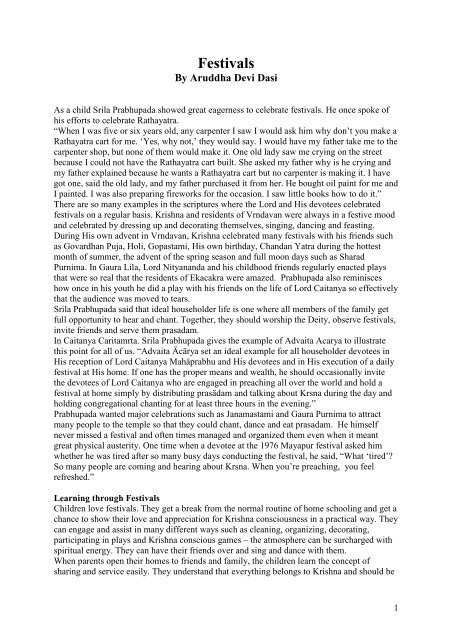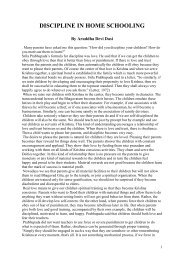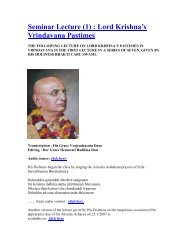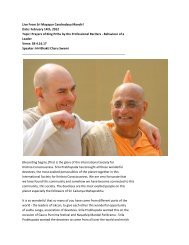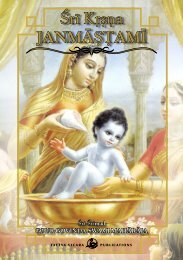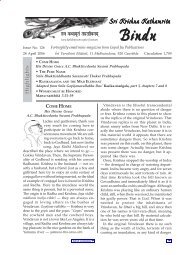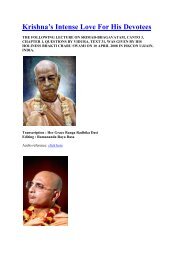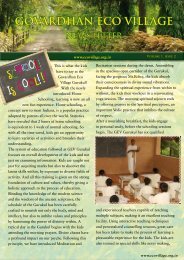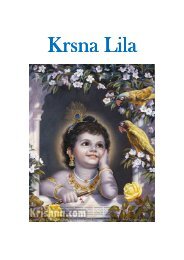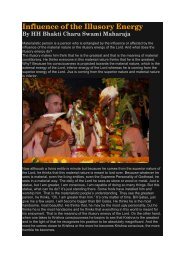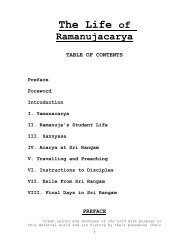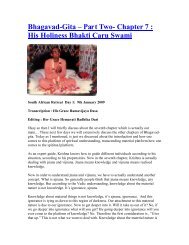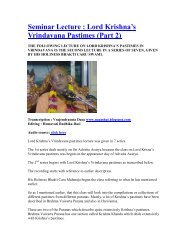Festivals - ebooks - ISKCON desire tree
Festivals - ebooks - ISKCON desire tree
Festivals - ebooks - ISKCON desire tree
Create successful ePaper yourself
Turn your PDF publications into a flip-book with our unique Google optimized e-Paper software.
<strong>Festivals</strong>By Aruddha Devi DasiAs a child Srila Prabhupada showed great eagerness to celebrate festivals. He once spoke ofhis efforts to celebrate Rathayatra.“When I was five or six years old, any carpenter I saw I would ask him why don’t you make aRathayatra cart for me. ‘Yes, why not,’ they would say. I would have my father take me to thecarpenter shop, but none of them would make it. One old lady saw me crying on the s<strong>tree</strong>tbecause I could not have the Rathayatra cart built. She asked my father why is he crying andmy father explained because he wants a Rathayatra cart but no carpenter is making it. I havegot one, said the old lady, and my father purchased it from her. He bought oil paint for me andI painted. I was also preparing fireworks for the occasion. I saw little books how to do it.”There are so many examples in the scriptures where the Lord and His devotees celebratedfestivals on a regular basis. Krishna and residents of Vrndavan were always in a festive moodand celebrated by dressing up and decorating themselves, singing, dancing and feasting.During His own advent in Vrndavan, Krishna celebrated many festivals with his friends suchas Govardhan Puja, Holi, Gopastami, His own birthday, Chandan Yatra during the hottestmonth of summer, the advent of the spring season and full moon days such as SharadPurnima. In Gaura Lila, Lord Nityananda and his childhood friends regularly enacted playsthat were so real that the residents of Ekacakra were amazed. Prabhupada also reminisceshow once in his youth he did a play with his friends on the life of Lord Caitanya so effectivelythat the audience was moved to tears.Srila Prabhupada said that ideal householder life is one where all members of the family getfull opportunity to hear and chant. Together, they should worship the Deity, observe festivals,invite friends and serve them prasadam.In Caitanya Caritamrta. Srila Prabhupada gives the example of Advaita Acarya to illustratethis point for all of us. “Advaita Äcärya set an ideal example for all householder devotees inHis reception of Lord Caitanya Mahäprabhu and His devotees and in His execution of a dailyfestival at His home. If one has the proper means and wealth, he should occasionally invitethe devotees of Lord Caitanya who are engaged in preaching all over the world and hold afestival at home simply by distributing prasädam and talking about Krsna during the day andholding congregational chanting for at least three hours in the evening.”Prabhupada wanted major celebrations such as Janamastami and Gaura Purnima to attractmany people to the temple so that they could chant, dance and eat prasadam. He himselfnever missed a festival and often times managed and organized them even when it meantgreat physical austerity. One time when a devotee at the 1976 Mayapur festival asked himwhether he was tired after so many busy days conducting the festival, he said, “What ‘tired’?So many people are coming and hearing about Krsna. When you’re preaching, you feelrefreshed.”Learning through <strong>Festivals</strong>Children love festivals. They get a break from the normal routine of home schooling and get achance to show their love and appreciation for Krishna consciousness in a practical way. Theycan engage and assist in many different ways such as cleaning, organizing, decorating,participating in plays and Krishna conscious games – the atmosphere can be surcharged withspiritual energy. They can have their friends over and sing and dance with them.When parents open their homes to friends and family, the children learn the concept ofsharing and service easily. They understand that everything belongs to Krishna and should be1
used in His service. They also learn the art of cooperation with other family members andfriends, for without them it would be impossible to hold festivals. They learn to see all tasks,even activities such as cleaning, to be as important as Deity worship and chanting. But mostof all they learn to relate to Krishna as a person - He is our most special guest at home. Takingpart in a play, wearing appropriate costumes, is also great fun for them. The culture ofKrishna consciousness becomes deeply imbedded in their hearts and mind and they carry fondmemories of them throughout their life. Besides who does not like congregational chanting,prasadam, plays, good clothes etc?If we look at our Vaishnava calendars practically every day is a celebration of one type oranother. During our home schooling days, my husband, Anantarupa Prabhu, was veryparticular to celebrate all festivals in a grand way. He encouraged us to make a collectivefamily effort for their success and open our doors to all who came to join us for thecelebrations. For days such as Janamastami, Gaura Purnima, Nrsinghadeva Caturdashi andDiwali we took two weeks off from the normal routine of home schooling. On other smallerfestivals and appearance or disappearance days of acharyas we took a day or two off. Duringthis time we dovetailed our study into learning about the festival and soon realized that thechildren did more study during those ‘off days’ than the regular ‘working days.’ For example,for Gaura Purnima, the appearance day of Lord Caitanya, we read about His advent and Hisearly childhood pastimes from the Caitanya Caritamrta. I gave them English assignmentsbased on what they read.We staged a play for most festivals, small or big, which required a script. We encouraged ourchildren to write a script which took a tremendous amount of work such as reading, writing,editing and summarizing. Twice a week they had their friends over and practiced for the play,getting a chance to direct and act in the play. During the weeks prior to the festival theirmotivation to learn was stronger than other days.How did we celebrate festivals?My husband guided us through that. For all festivals we decorated the altar and dressed theDeities gorgeously with fresh clothes. We had a nice play in which we engaged children ofdevotees and congregation members, some special bhajans, dances and prasadam.We designed costumes and made props for the plays (that took care of their school artlessons). For example, just even making a bow and arrow for Lord Rama, a scenic backdropor Govardhan Hill out of paper mache took much planning and tested our basic art skills. Wealso spent a substantial amount of time planning, shopping and cooking for the Deities’ foodoffering. We celebrated other festivals such as the appearance and disappearance days of ouracharyas in the same manner. In the week prior to the festival, we would read the biographyof that acarya. On the day, we would cook for them and offer pushpanjali and artik. Frankly,this is primarily what we did for our home schooling - plan festivals, temple programs, Deityworship and organize preaching activities, and any success we had was a result of this.Prabhupada gave many lectures on how to celebrate festivals and we can take guidance fromthem. In a 1972 room conversation in Vrndavan he explained the different kinds of festivalson the Vaishnava calendar, their spiritual significance, how they should be celebrated andhow we should fast on those days. He wanted us to celebrate all festivals that he noted on thecalendar as well as the appearance and disappearance days of our acharyas. Below is anexcerpt from that conversation:“The next important day is on the 26th, no, 12 th September, 12th September, 1970, the adventday of Sri Jiva Gosvami Prabhu. (pause) On that day there are three functions. First of all,Ekädasi, a special Ekädasi called Parsvaika Ekadasi. Then on that day, actually, Ekadasiaccording to calendar, Ekadasi was to be observed on the 11th September, but because the2
next day is Vamana Dvadasi.... Vamana Dvadasi means the advent of Lord Vämanadeva.Therefore we have fast., Ekadasi fasting, and we observe two fastings in one day, Ekadasi andVamanadeva, Vamana Dvadasi. The same process as we observe Ekadasi, and the eveningthere should be a meeting discussing on the life and work of Srila Jiva Gosvami. He is one ofthe very mportant äcäryas in our sampradäya, so especially his Sandarbhas should bediscussed. If there is no such book, then the following discussion may be, take place.”The question may arise as to whether children should be encouraged to fast on festivals. Untilthe age of ten I did not encourage total fasting but if they did wanted to do some, I had foodreadily available in case they got hungry. Sometimes children want to imitate and try to fastbut cannot manage for very long. During such predicaments, giving them food without grainsis a good option so that they are also doing some austerities but enjoy doing them.On Ekadasis I had plenty of food such as buckwheat, potato and other non-grain items so theycould fast from grains without difficulty. Gradually their stamina for fasting increased, andas they grew older they were able to do full fasts on days such as Janmastami.Children love to play; therefore celebrating festivals is a great way to dovetail their playingtendency into something meaningful. They learn valuable practical skills while fixing theirminds on Krishna. If we don’t engage them in these activities they will spend their timeplaying with meaningless toys and games.The things that I remember most about my own childhood in Allahabad, India were myparticipation in festivals such as Holi, Diwali and Dassehra. My parents celebrated allfestivals with enthusiasm especially Janmastami and Nandostava, and distributed hundreds ofgifts to people every year. I remember fondly the yearly Dassehra in Allahabad whenhundreds of floats depicting Lord Rama’s pastimes were decorated and my father would makeprior arrangements so that they waited extra time in front of our house so that we could seethem to our heart’s content. Then on the last day of the week-long festival he would wake usup early and take us to a special place where Lord Rama was residing and we would touchHis feet and do aarti. This was my favorite festival growing up as a child.We can now pass these traditions that we imbibed from our parents to our children in ameaningful way, by following Srila Prabhupada’s instructions. Let us not be reluctant aboutcelebrating these holidays with our children, thereby helping them to become more Krishnaconscious. It may mean some hard work on our part but the results are lasting. Children lovefestivities, color, song, dance, good food, but who doesn’t?3


